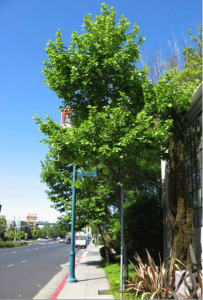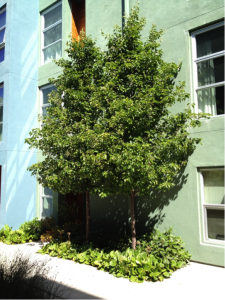Blog post by Fei Mok, 2016-17 Bay Area Fellow
When the City of Emeryville was developing our Sustainability Action Plan, one of the major issues we looked into was the climate resilience of the city street trees. The idea was spurred by Ruth Akins, one of the City Council members, who was interested in whether specific tree species were better at sequestering carbon than others. These species could be prioritized in a preferred street tree list for new construction sites when developers and architects are preparing their documents and determining landscaping.
Steve and Molly Batchelder, a father-daughter arborist consulting duo, were integral to helping the City determine the best street trees for this list. Carbon sequestration is essentially a product of how fast trees grow and develop new wood. Different tree species have varying capacities for carbon sequestration, but reaching the maximum potential depends on having optimum root condition and location – the better the growing condition, the faster the tree will sequester carbon.
 Given the expected continuation of California’s drought conditions, trees that require less water and have greater tolerance for hot dry weather would thrive the best in Emeryville. Some of the trees selected include the boxelder (Acer negundo), a California native tree with moderate water use; the silver dollar gum (Eucalyptus polyanthemos), a large drought tolerant tree; and Monterey cypress (Hesperocyparis macrocarpa), another California native tree. The complete climate resilient street tree list for Emeryville can be found at the City of Emeryville website. Cal Poly’s Urban Forest Ecosystems Institute was a valuable resource in exploring different tree species and their tolerances as well as optimal growing conditions.
Given the expected continuation of California’s drought conditions, trees that require less water and have greater tolerance for hot dry weather would thrive the best in Emeryville. Some of the trees selected include the boxelder (Acer negundo), a California native tree with moderate water use; the silver dollar gum (Eucalyptus polyanthemos), a large drought tolerant tree; and Monterey cypress (Hesperocyparis macrocarpa), another California native tree. The complete climate resilient street tree list for Emeryville can be found at the City of Emeryville website. Cal Poly’s Urban Forest Ecosystems Institute was a valuable resource in exploring different tree species and their tolerances as well as optimal growing conditions.
 By developing this climate resilient tree species list, we can ensure that trees planted in the coming years are best suited to drought and heat, as well as provide the most accurate information on proper tree care to developers and architects when selecting trees for new development sites. Trees are crucial not only for sequestering carbon, but also for mitigating urban heat, purifying the air, and providing habitat for birds and wildlife. We want our trees to be healthy so that we in turn can live in green, healthy environments.
By developing this climate resilient tree species list, we can ensure that trees planted in the coming years are best suited to drought and heat, as well as provide the most accurate information on proper tree care to developers and architects when selecting trees for new development sites. Trees are crucial not only for sequestering carbon, but also for mitigating urban heat, purifying the air, and providing habitat for birds and wildlife. We want our trees to be healthy so that we in turn can live in green, healthy environments.
